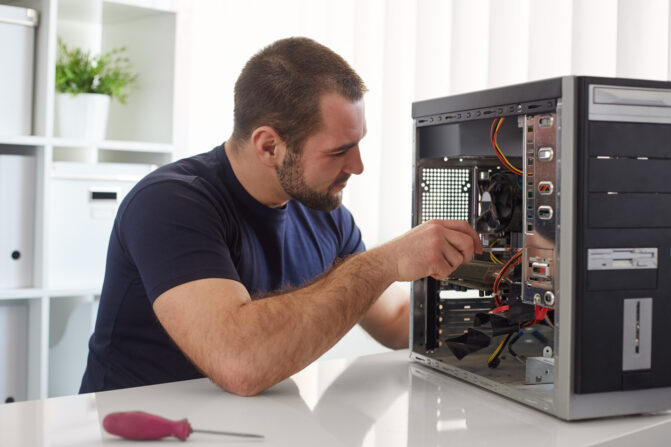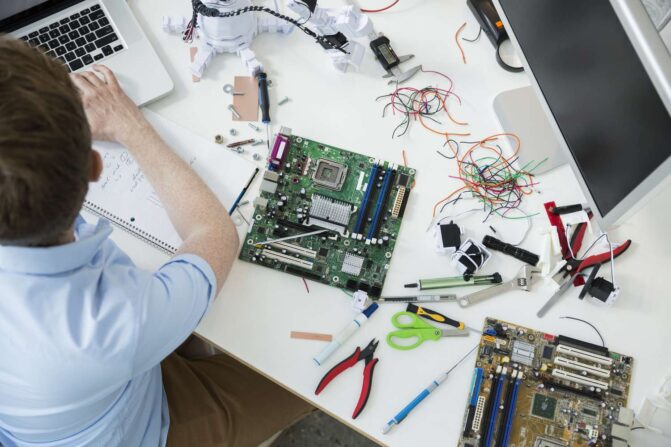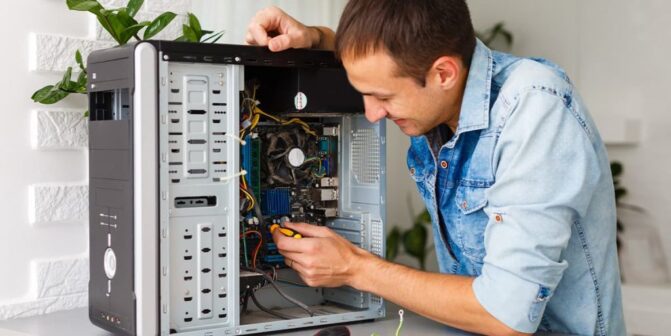Our everyday lives now revolve around computers, whether it be for business, leisure, or communication. They may, however, run into problems that need repairs and maintenance, just like any complicated machine. The safest and simplest alternative could be to take your computer to a professional repair facility, but it can also be costly and time-consuming. DIY maintenance and repairs are helpful in this situation.
A handy and affordable approach to maintaining and repairing minor computer problems is by performing your repairs and maintenance. The dangers and disadvantages of making repairs on your own should be considered, though. In this post, we’ll cover the best advice for conducting your computer maintenance and repairs, as well as the advantages and disadvantages of doing it yourself vs taking your computer to a repair facility. You’ll have a better grasp of how to fix your computer after this article, and you’ll be able to decide for yourself whether to attempt repairs on your own or hire a professional.
If you find any task too tough for yourself and if you are looking anywhere around Raleigh for computer repair then make sure you find on this site what you need.
Safety First

It’s important to discuss safety before we get into the recommendations. Computers are electrically powered equipment, which means that if they are used improperly, they might be deadly. It is essential to seek out expert assistance if you lack confidence in your technical abilities. If you’re set on doing it yourself, make sure to disconnect the computer and put on an anti-static wristband first. It is essential to safeguard both yourself and your PC, which contains several delicate components.
Step 1 – Identifying the Problem
Finding the issue is the first step in fixing your computer. You must identify the issue before you can resolve it, whether it is a hardware or software one. If the issue is a software one, you may resolve it by running a malware removal application or a virus check. If it’s a hardware issue, you might need to swap out a part or component.
Step 2 – Research the Problem
After you’ve located the issue, you should look into potential solutions. The internet is a great place to look for answers to common computer problems. Use trusted sources instead, such as well-known tech blogs or official manufacturer websites. Be cautious when visiting websites that request that you download software or click on ominous links.
Step 3 – Prepare Your Tools
Make sure you have all the required tools on hand before starting the repair. This contains any replacement components you require, pliers, and screwdrivers. Having a dust- and debris-free workstation is also a good idea.
Step 4 – Backup Your Data
Backing up your data is a must before making any changes to your computer. All of your papers, files, and media are included here. You don’t want to lose all your crucial data if something goes wrong during the repair procedure. To back up your data, you can use a USB device, an external hard disk, or cloud storage.
Step 5 – Be Patient
Computer repairs might take a long time to complete. Along the route, you can run into unanticipated problems or come into obstacles. To make sure you’re making the appropriate adjustments, you must be patient and take your time. Rushing the repair work might result in more issues in the future.
Make sure you research the advantages and disadvantages of doing your repairs vs visiting a PC repair company before you start fiddling!
Benefits of DIY Repairs

1. Cost Reduction
The ability to save money is one of the main advantages of DIY repairs. By fixing the computer on your own, you may save money on labour.
2. Convenience
DIY fixes are practical since you can fix your computer whenever you want to, without having to wait for a repair shop appointment.
3. Knowledge
You’ll learn and develop skills by doing it yourself that you may use to resolve computer issues in the future.
Drawbacks of DIY Repairs
1. Risk
DIY repairs come with risks since you might unintentionally hurt yourself or significantly damage your computer.
2. Time-Consuming
DIY repairs can take a lot of time, especially if you’re not familiar with the procedure.
3. Lack of Expertise
You may lack the essential skills to resolve more complicated problems if you are unfamiliar with computer repair.
Benefits of PC Repair Shops

1. Expertise
PC repair services use trained and skilled professionals that can quickly and effectively diagnose and resolve complicated computer problems.
2. Warranty
Taking your computer to a repair facility will guarantee that the repairs are made appropriately and won’t breach the warranty if it is still covered by one.
3. Safety
You may steer clear of any potential safety issues connected with do-it-yourself repairs by taking your computer to a repair shop.
Drawbacks of PC Repair Shops
1. Cost
Shops for PC repair can be pricey, particularly for more difficult fixes.
2. Inconvenience
It might be annoying to take your computer to a repair shop since you may need to make an appointment and wait while the repairs are made.
3. Lack of Restraint
When you bring your computer to a repair facility, you cede control of the process and place your faith in the expert to do the work appropriately.
Conclusion

In conclusion, computers are intricate devices that require precise upkeep and maintenance to operate well. DIY maintenance and repairs can save money and be handy, but they also carry some potential dangers. Prioritizing safety and taking the necessary time to plan and study is crucial before starting any repairs. It is recommended to seek out professional assistance if you lack confidence in your technical knowledge or if the problem is beyond your area of specialization. Computer repair companies provide the expertise, equipment, and experience necessary to quickly and securely identify and resolve complicated issues.
You can prolong the life of your computer and save money over time by adhering to the best advice for do-it-yourself repairs and maintenance. Always put safety first, back up your data, and exercise patience. Your computer will continue to be an invaluable tool in your everyday life if you take good care of it.